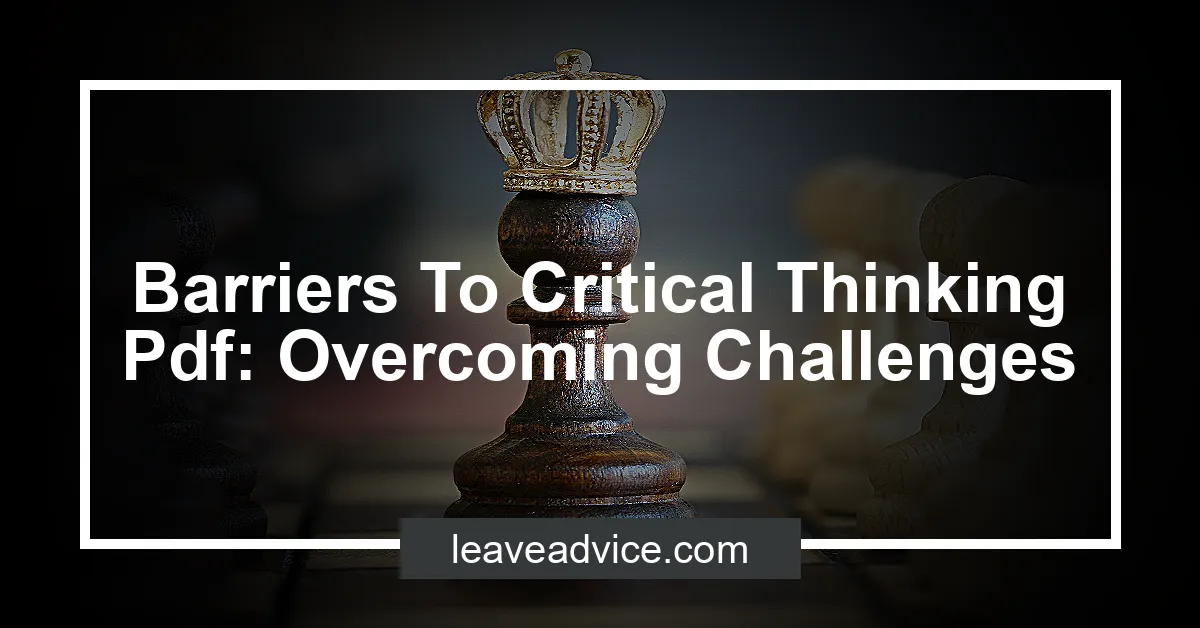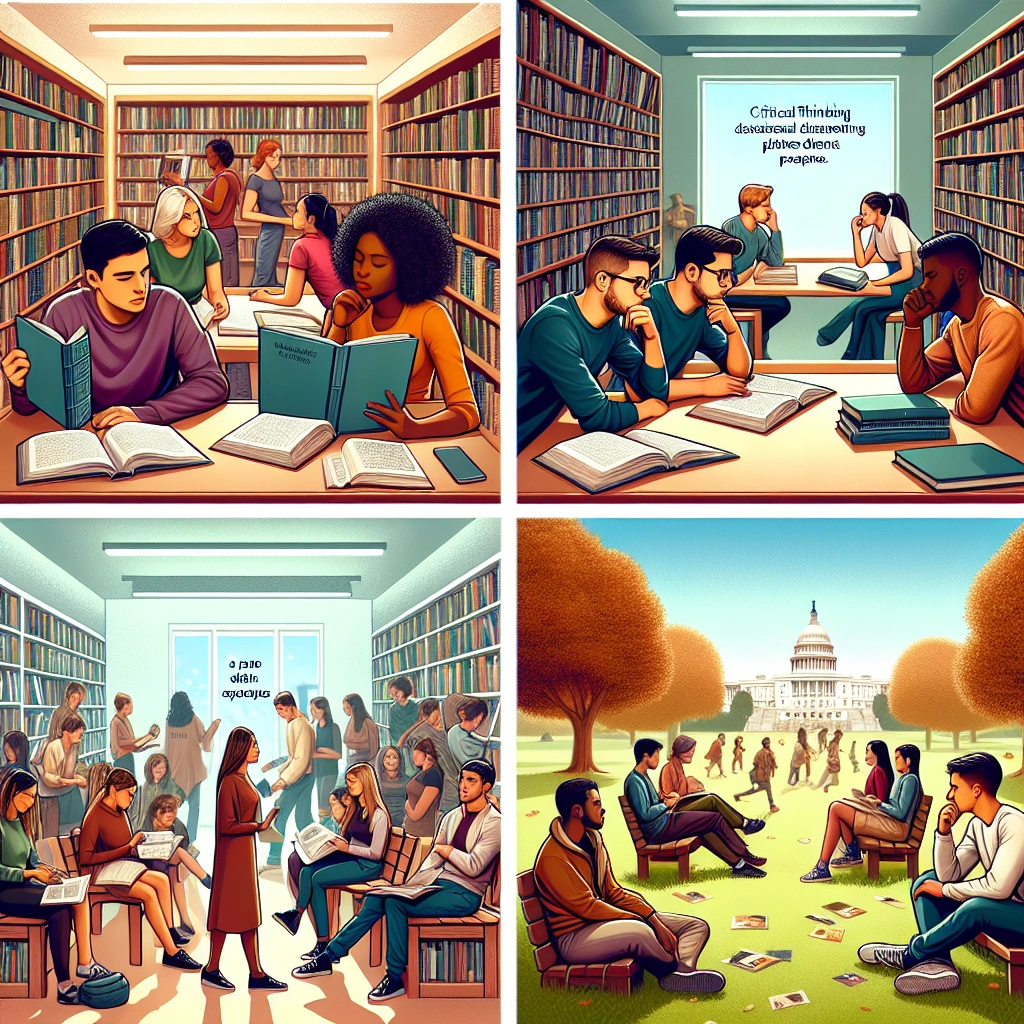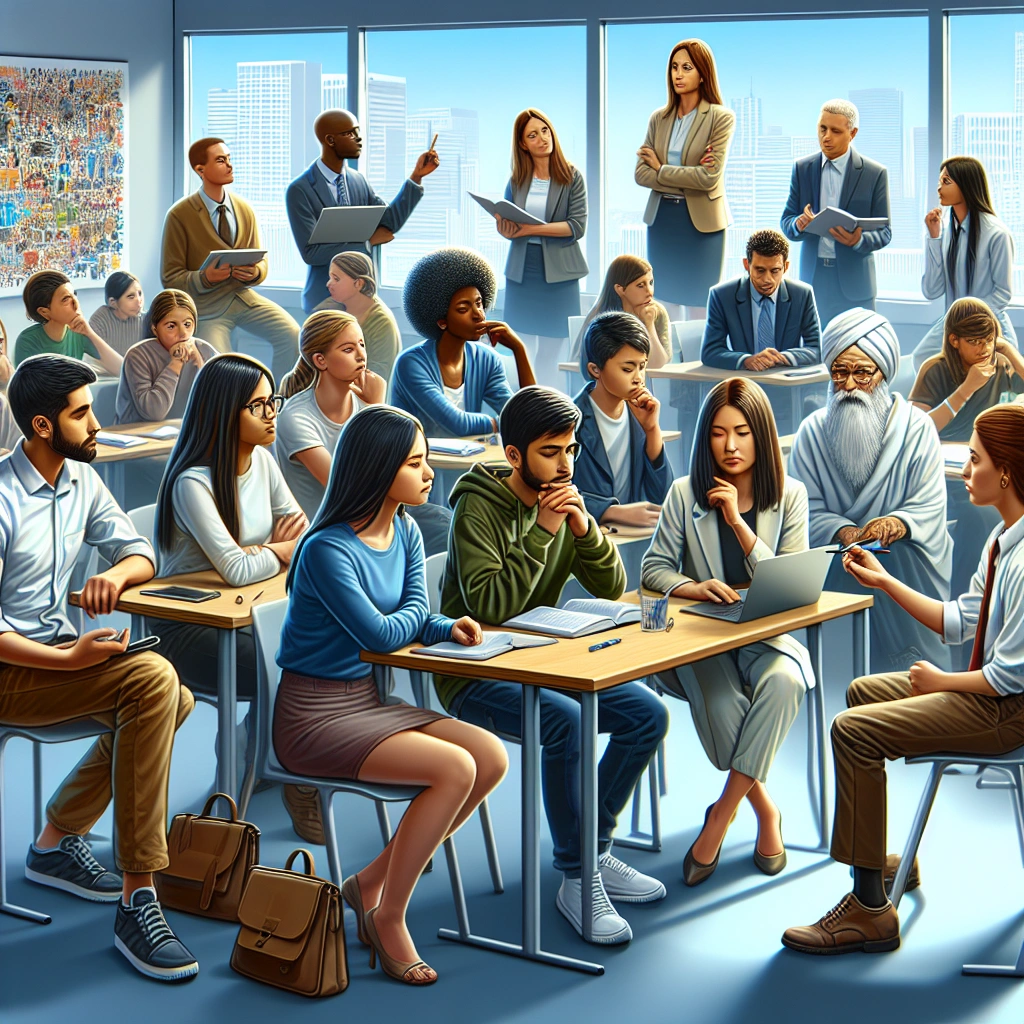Barriers To Critical Thinking Pdf: Overcoming Challenges


Critical thinking is the ability to effectively analyze information and form judgments. It involves asking questions, gathering relevant information, thinking through solutions, and considering alternative systems.
Barriers to critical thinking can hinder this process, including unwarranted assumptions, personal biases, egocentric thinking, and emotions that inhibit clear thinking. The focus of this article is on overcoming barriers to critical thinking and is available in PDF format for easy access and reference.
Check out this Youtube video: Learn how to overcome barriers to critical thinking by watching this informative and insightful video on Chapter 04 Critical Thinking.
Understanding Critical Thinking
Explanation of critical thinking
In essence, critical thinking involves the active and deliberate process of analyzing, synthesizing, and evaluating information to make informed judgments and decisions. It requires individuals to question, interpret, and objectively assess the information they encounter, thus enabling them to overcome biases and cognitive limitations when processing data.
Critical thinking is akin to a mental discipline that fosters logical reasoning, analytical skills, and an open mindset, allowing for the development of informed and rational perspectives.
Characteristics of critical thinkers
Highly effective critical thinkers possess several key characteristics that set them apart. These include curiosity, compassion, mindfulness, decisiveness, and honesty.
Curiosity fuels the drive to seek new information, while compassion ensures a balanced and empathetic approach to analysis. Mindfulness enables individuals to maintain focus and mental acuity, and decisiveness ensures timely and firm decision-making.
Honesty underpins the integrity of critical thinking, promoting transparency and ethical evaluation of information.
Importance of critical thinking in decision-making and problem-solving
Critical thinking serves as a fundamental skill that significantly enhances decision-making and problem-solving capabilities. By fostering logical reasoning, analytical skills, and an open mindset, it equips individuals with the ability to cut through misinformation, make wise decisions, and solve intricate issues effectively.
The skill promotes the evaluation of information, using logic, reasoning, and creativity to draw relevant conclusions, ultimately enabling individuals to understand situations better and make informed choices.
| Traits of Critical Thinkers | Description |
|---|---|
| Curiosity | A drive to seek new information |
| Compassion | Consideration of various perspectives |
| Mindfulness | Maintaining focus and mental acuity |
| Decisiveness | Timely and firm decision-making |
| Honesty | Ethical evaluation and transparency |
Critical thinking is a transformative skill that not only enhances cognitive abilities but also contributes to the development of robust decision-making and problem-solving skills essential for personal and professional success.
Types of Barriers to Critical Thinking
Emotional barriers
Emotional barriers hinder critical thinking by clouding judgment and decision-making. These barriers arise from personal feelings, including fear, anger, or excitement, which can influence individuals to make impulsive or biased choices rather than rational ones.
Cognitive biases
Cognitive biases pose significant obstacles to critical thinking as they involve the mind’s inherent tendency to make systematic deviations from rationality. Confirmation bias, hindsight bias, and misinformation effect are common examples of cognitive biases that lead individuals to overlook evidence, focus on supporting existing beliefs, and distort perceptions of reality.
Social and cultural influences
Social and cultural influences impede critical thinking by shaping individuals’ perspectives and behaviors based on societal norms, values, and expectations. People may conform to group-biased opinions or be influenced by cultural paradigms, hindering their ability to objectively evaluate information and make independent decisions.
Personal beliefs and assumptions
Personal beliefs and assumptions act as barriers to critical thinking when individuals rely on preconceived notions rather than factual evidence. These beliefs, often ingrained from personal experiences or cultural upbringing, can lead to a closed-minded approach, making it challenging to consider alternative viewpoints or new information critically.
Recognizing Barriers in PDF Documents
Common barriers found in PDF materials
- The most common barriers found in PDF materials include improper tagging, lack of alternative text, and inconsistent reading order.
- Improper tagging can make it difficult for screen readers to interpret the content, while missing alternative text hinders accessibility for visually impaired individuals.
- Inconsistent reading order can disrupt the flow of information and make it challenging for users to grasp the content effectively.
Impact of PDF formatting on critical thinking
- The impact of PDF formatting on critical thinking can be significant, as it often hampers the seamless absorption of information.
- Complex layouts and inaccessible features in PDF documents can create cognitive overload, impeding the ability to analyze and interpret the content critically.
- The rigid structure of PDFs may limit interactive engagement, hindering the process of questioning and evaluating information thoroughly.
Examples of how PDF documents can hinder critical thinking
| Issue | Impact |
|---|---|
| Lack of proper tagging | Limits accessibility for screen reader users, hindering their ability to critically engage with the content. |
| Inaccessibility of visual elements | Impedes the critical analysis of images and charts, affecting the holistic understanding of the presented information. |
| Disrupted reading order | Hampers the sequential comprehension of ideas, impacting the ability to critically evaluate the logical flow of the document content. |
Overcoming Emotional Barriers in Critical Thinking PDFs
Identification of emotional barriers in PDF materials
Identifying emotional barriers within PDF materials can be challenging, but common examples include cognitive biases, personal beliefs, and cultural influences that hinder objective analysis. These barriers often manifest as emotional reasoning, where individuals let their feelings override evidence and logic.
Strategies to address emotional biases while reading PDFs
Employing strategies to address emotional biases while reading PDFs is crucial. One effective approach is mindfulness, which involves being aware of one’s emotional responses and consciously redirecting focus back to objective analysis.
Additionally, engaging in diverse sources and seeking alternative viewpoints can help counteract emotional biases.
How to remain objective and rational when encountering emotional content in PDFs
Remaining objective and rational when encountering emotional content in PDFs requires self-awareness and critical reflection. It’s vital to acknowledge one’s emotional responses, then consciously shift focus to evidence-based reasoning.
Furthermore, actively questioning assumptions and seeking contrary evidence can aid in maintaining objectivity. Practicing empathy and considering alternative perspectives also fosters rational analysis.
| Emotional Barriers | Strategies to Address Emotional Biases | Objectivity and Rationality |
|---|---|---|
| Cognitive biases | Mindfulness and self-awareness | Self-reflection and empathy |
| Cultural influences | Diverse sources and alternative viewpoints | Critical questioning and contrary evidence |
Addressing Cognitive Biases in PDF Documents
Understanding common cognitive biases in PDF materials
Common cognitive biases in PDF materials can include the availability bias, confirmation bias, and the bandwagon effect. The availability bias occurs when individuals rely on information readily available in the PDF, while confirmation bias leads them to seek and interpret information that aligns with their existing beliefs.
Additionally, the bandwagon effect results in individuals adopting certain beliefs because many others DO. These biases can significantly impact how individuals interpret and internalize information from PDF documents.
Techniques to combat cognitive biases when reading PDFs
To combat cognitive biases, individuals can employ various techniques such as actively seeking out diverse perspectives, critically assessing the credibility of the sources within the PDF, and engaging in reflective thinking to identify and challenge their own biases. Additionally, employing fact-checking methodologies, consulting multiple sources, and being open to alternative viewpoints can help mitigate the impact of cognitive biases when reading PDFs.
Incorporating diverse perspectives and critical analysis while engaging with PDF content
Incorporating diverse perspectives involves seeking out materials from a wide range of authors and sources to gain a comprehensive understanding of the topic. Additionally, critical analysis entails assessing the reliability and relevance of the information presented in the PDF, questioning assumptions, and considering alternative viewpoints.
Actively engaging in discussions with individuals who hold differing opinions can also enrich the understanding of the PDF content and reduce the influence of cognitive biases.
Navigating Social and Cultural Influences in PDFs
Impact of social and cultural influences on critical thinking in PDFs
Social and Cultural Impact: The influence of social and cultural factors on critical thinking within PDFs is profound. For instance, different cultural backgrounds may shape individual perspectives, affecting how one critically evaluates information in PDFs. Social influences, such as media and societal norms, can mold critical thinking patterns, potentially leading to biased interpretations and conclusions when consuming PDF content.
Ways to recognize and challenge biased viewpoints in PDF documents
Recognizing Bias: Uncovering biased viewpoints in PDFs involves critically evaluating the sources, examining language choices, and identifying any potential agenda or prejudice. Additionally, cross-referencing information from diverse PDF sources and seeking multiple perspectives can help in recognizing and challenging biased viewpoints. It is essential to engage in discussions with a broad range of individuals to assess different viewpoints and challenge one’s own biases.
Promoting open-mindedness and cultural sensitivity when consuming information in PDF format
Cultural Sensitivity: Encouraging open-mindedness and cultural sensitivity while consuming PDF content involves actively seeking diverse perspectives and considering the cultural context of the information presented. Embracing open dialogue and understanding the cultural influences behind the content can foster a more inclusive and critical approach to leveraging information from PDFs. It is crucial to actively practice empathy and respect for diverse cultural perspectives, fostering a more comprehensive and unbiased interpretation of PDF information.
| Benefits of Promoting Cultural Sensitivity |
|---|
| – Enhanced critical thinking skills |
| – Fostering inclusive work environments |
| – Improved decision-making processes |
| – Encouraging diversity of thought |
Recognizing the impact of social and cultural influences, challenging biased viewpoints, and promoting cultural sensitivity are pivotal in navigating PDF content with a critical mindset. Embracing these principles can enhance critical thinking skills and contribute to a more inclusive and open-minded approach in consuming and analyzing information within PDF documents.
Challenging Personal Beliefs and Assumptions in PDFs
Identifying personal biases and assumptions while reading PDF materials
To identify personal biases and assumptions when reading PDF materials, it’s important to reflect on our preconceived notions and underlying beliefs. One method is to question the source of the information and consider how our own experiences may influence our interpretation.
For example, when reading about a controversial topic, acknowledging our emotional response and seeking diverse perspectives can help uncover biases.
Methods to critically evaluate and validate personal beliefs in PDF documents
When critically evaluating and validating personal beliefs in PDF documents, it’s essential to fact-check the information and cross-reference it with reputable sources. Additionally, applying the Socratic method of questioning and deliberating on the evidence presented can help in the validation process.
For instance, examining the credibility of the author and assessing the supporting evidence can aid in distinguishing between opinions and empirical facts.
Encouraging self-reflection and openness to alternative perspectives when encountering conflicting ideas in PDFs
To encourage self-reflection and openness to alternative perspectives when encountering conflicting ideas in PDFs, individuals can engage in active listening and empathetic understanding. Embracing cognitive humility, which involves admitting that our knowledge may be limited, can foster receptiveness to new viewpoints.
For instance, actively seeking out dissenting opinions and engaging in constructive dialogue can lead to a more comprehensive understanding of complex issues.
Enhancing Critical Thinking Skills with PDF Tools and Features
Utilizing PDF annotation tools for active reading and critical analysis
PDF annotation tools like Adobe Acrobat Reader and PDFescape offer features for active reading and critical analysis. These tools allow users to add comments, highlight important sections, and make annotations directly on the PDF.
For example, Adobe Acrobat Reader provides a range of annotation options, including sticky notes, highlights, and text comments, enabling users to engage with the content actively.
Incorporating digital highlighters, comments, and bookmarks to enhance critical thinking
Digital highlighters, comments, and bookmarks are integral to enhancing critical thinking when engaging with PDFs. These features enable users to mark important sections, add comments for reflection, and create bookmarks for easy navigation within the document.
By utilizing these tools effectively, individuals can organize their thoughts, make connections, and critically analyze the content.
Leveraging search and navigation features in PDFs to connect ideas and form logical arguments
Search and navigation features in PDFs play a pivotal role in connecting ideas and forming logical arguments. With functions provided by tools like Adobe Acrobat, users can search for specific keywords or phrases within the document, facilitating the process of finding relevant information.
Additionally, navigation features such as page thumbnails and automatic scrolling aid in seamless movement through the content, allowing for a comprehensive analysis and synthesis of ideas.
| Annotation Tools | Features | Pros | Cons | Pricing |
|---|---|---|---|---|
| Adobe Acrobat Reader | Various annotation options, search functionality | User-friendly, widely used | Subscription cost PDFescape | |
| Annotation and form-filling capabilities | Free version available | Limited advanced features PDF Annotator | ||
| Wide range of annotation tools | Versatile for different markup needs | Higher price point |
The incorporation of PDF annotation tools, digital highlighters, comments, and navigation features enables individuals to enrich their critical thinking skills when engaging with digital content. These tools provide a structured approach to active reading, analysis, and the formation of logical arguments within PDF documents.
Resources for Developing Critical Thinking in PDF Format
Access to educational materials and resources for improving critical thinking skills in PDF
- Insight Assessment offers a wide array of downloadable PDF resources for enhancing critical thinking skills. These resources include lesson plans, rubrics, and curriculum guides, aiding teachers in planning engaging critical thinking activities.
Online courses and PDF-based learning modules focused on critical thinking development
- Coursera provides a vast selection of online courses and certificates tailored to enhancing critical thinking skills. The courses offer a convenient and flexible way for individuals to acquire and improve critical thinking abilities through customizable skill levels.
Recommendations for downloadable PDF books and articles that promote critical thinking abilities
- The Miniature Guide to Critical Thinking Concepts and Tools, available for download, serves as a comprehensive resource for developing critical thinking skills. Additionally, “Critical Thinking Skills” by Stella Cottrell stands as a valuable PDF resource offering insights into reasoned decision-making.
The Impact of Digital Technology on Critical Thinking in PDFs
Discussion on the influence of digital devices and screens on critical thinking processes
Digital devices and screens have significantly impacted critical thinking processes. With the constant bombardment of information and the temptation of multitasking, individuals are often left skimming through PDFs and documents instead of engaging in deep, analytical reading.
The digital era has created a culture of quick browsing, where individuals easily fall into a pattern of superficial understanding rather than delving deeply into the content. The immediate access to information, although advantageous, has led to a decline in sustained focus and critical analysis when engaging with PDFs.
Exploring the effects of multitasking and information overload on critical thinking while using PDFs
The modern trend of multitasking while consuming digital content has majorly impacted critical thinking, especially when dealing with PDFs. Multitasking compromises the depth of comprehension and analytical thinking, as individuals fail to allocate undivided attention to the material at hand.
Moreover, the constant exposure to information overload has led to cognitive fatigue, hindering the ability to critically evaluate and internalize the content of PDFs. This overload diminishes the capacity for deep critical thinking, resulting in surface-level understanding.
Strategies to mitigate the negative impact of digital technology and promote focused, analytical reading in PDF format
To counter the negative impact of digital technology on critical thinking when using PDFs, employing strategies to promote focused and analytical reading is essential. Implementing techniques such as time-blocking for uninterrupted reading and creating a conducive environment free from digital distractions can greatly enhance critical thinking.
Additionally, advocating for mindfulness practices to combat information overload and fostering a culture of deliberate, slow reading can contribute to the development of robust critical thinking skills when engaging with PDFs.
| Strategies to Mitigate Negative Impact | Benefits |
|---|---|
| Time-blocking for uninterrupted reading | Enhanced focus and deep comprehension |
| Creating a conducive environment free from digital distractions | Reduced cognitive overload and improved critical analysis |
| Advocating for mindfulness practices | Enhanced capacity for deep critical evaluation |
| Fostering a culture of deliberate, slow reading | Development of robust critical thinking skills |
In an era where digital technology dominates, instilling mindfulness and intentional reading practices is crucial to cultivating and preserving strong critical thinking abilities, especially within the realm of PDF consumption.
Engaging with Diverse Perspectives in PDF Documents
Importance of exposure to diverse viewpoints and ideas in critical thinking
Exposure to diverse viewpoints and ideas in critical thinking is crucial as it allows individuals to consider multiple perspectives, challenging their own beliefs and assumptions. This exposure fosters open-mindedness, creativity, and the ability to make well-informed decisions.
By engaging with diverse viewpoints, critical thinkers can expand their cognitive skills and enhance their problem-solving abilities, ultimately driving innovation.
Guidance on seeking out and analyzing conflicting opinions within PDF materials
When seeking out and analyzing conflicting opinions within PDF materials, it’s important to actively look for sources that present varying viewpoints on the topic. To effectively analyze these conflicting opinions, critical thinkers should assess the credibility, biases, and evidence behind each perspective.
It’s essential to critically evaluate the sources, considering the author’s expertise, potential motives, and the quality of supporting evidence presented. This process enables individuals to make informed judgments and gain a comprehensive understanding of the subject matter.
Examples of how embracing diversity of thought can strengthen critical thinking skills when reading PDFs
Embracing diversity of thought when reading PDFs strengthens critical thinking skills by exposing individuals to different cultural, social, and intellectual perspectives. For instance, when reading scholarly articles from diverse authors, individuals can gain insights from contrasting viewpoints, challenging their preconceptions and expanding their knowledge.
Additionally, embracing diversity of thought cultivates empathy and tolerance, essential elements in fostering well-rounded critical thinking skills. This inclusivity enriches the learning experience and encourages individuals to approach problem-solving with greater depth and understanding.
| Diverse Viewpoints | Strengthened Critical Thinking |
|---|---|
| Multiple perspectives challenge beliefs | Enhances cognitive skills |
| Fosters open-mindedness and creativity | Cultivates empathy and tolerance |
| Expands problem-solving abilities | Drives innovation |
Engaging with diverse perspectives in PDF documents is instrumental in cultivating robust critical thinking skills, enriching knowledge, and promoting inclusivity in learning and decision-making. By valuing and embracing diversity of thought, individuals can broaden their horizons, enhance their cognitive abilities, and contribute to innovative and well-informed discourse.
Incorporating Critical Thinking in PDF-Based Research and Academia
Challenges in promoting critical thinking in scholarly PDF documents
One of the main challenges in promoting critical thinking in scholarly PDF documents is the dense and technical language often used. This can create barriers for readers, making it difficult for them to engage in critical analysis of the content.
Strategies for students and academics to cultivate critical thinking within academic PDFs
Students and academics can cultivate critical thinking within academic PDFs by actively engaging with the material through annotation and discussion. Encouraging open dialogues and debates around the content can also foster critical thinking skills.
Recommendations for integrating critical analysis into research and scholarly writing in PDF format
To integrate critical analysis into research and scholarly writing in PDF format, it is essential to promote diverse perspectives and encourage questioning of assumptions. Additionally, incorporating activities that require analysis and synthesis of information can enhance critical thinking abilities.
Overcoming Language Barriers in Multilingual PDFs
Methods for critical evaluation and comprehension of information in multilingual PDF materials
To ensure critical evaluation and comprehension of information in multilingual PDFs, it is essential to use language-agnostic visual aids such as infographics, charts, and diagrams to convey complex ideas. Providing concise summaries in multiple languages alongside the PDF content can also assist in enhancing comprehension for multilingual audiences.
Tips for navigating language differences and cultural nuances in PDF content
When navigating language differences and cultural nuances in PDF content, utilizing plain and clear language is crucial. Avoiding slang, idioms, and cultural references that may not be universally understood is important.
Additionally, the use of reliable translation services and interpreters can aid in bridging language gaps and ensuring accurate communication.
Tools and resources for language translation and cross-cultural understanding in PDF format
There are various tools and resources available for language translation and cross-cultural understanding in PDF format. Translation tools such as Google Translate, Microsoft Translator, and DeepL can be valuable for accurate and user-friendly multilingual translation of PDF documents.
Furthermore, interpretation and translation resources offer additional support for ensuring meaningful cross-cultural communication.
| Tool/Resource | Description |
|---|---|
| Google Translate | Supports a wide range of languages, facilitating accurate multilingual translation |
| Microsoft Translator | A reliable tool for precise language translation, enhancing cross-cultural understanding |
| DeepL | Offers accurate and user-friendly translation services, aiding in effective cross-cultural comm |
| Interpretation and Translation Resources | Contains multiple resources for interpretation and translation, ensuring accurate communication |
With these methods, tips, and resources, overcoming language barriers in multilingual PDFs becomes more manageable, promoting effective communication and comprehension across diverse linguistic and cultural contexts.
All in all, language barriers should not impede effective communication and understanding. By employing targeted strategies and utilizing suitable resources, individuals and organizations can navigate multilingual PDF content with greater ease, fostering enhanced comprehension and inclusive communication.
Leveraging Visual and Audio Elements for Critical Thinking in PDFs
The role of visual and audio content in stimulating critical thinking skills within PDFs
Visual and audio content play a pivotal role in stimulating critical thinking skills within PDFs by offering alternative perspectives and engaging multiple senses. When compelling visuals and audio elements are incorporated, they have the power to spark curiosity, prompt deeper analysis, and encourage diverse interpretations, thereby enhancing the overall critical thinking process.
Examples of how images, graphs, and multimedia enhance critical analysis in PDF materials
In PDFs, images, graphs, and multimedia can significantly enhance critical analysis. For instance, infographics can distill complex data into digestible formats, empowering readers to scrutinize information from various angles.
Additionally, interactive multimedia elements such as videos or audio clips can provide nuanced insights, offering a dynamic dimension to textual information, thus promoting comprehensive critical analysis.
Best practices for interpreting and evaluating visual and audio information presented in PDF format
When interpreting and evaluating visual and audio information in PDFs, it’s crucial to prioritize authenticity and relevance. Ensuring that visual elements are sourced from credible origins and that audio content is accurately attributed helps in promoting an environment of trust and reliability.
Furthermore, employing clear labeling and contextual explanations alongside visual and audio content aids in fostering a robust framework for critical interpretation, enabling readers to navigate and comprehend the material with confidence.
| Visual and Audio Elements in PDFs | Benefits |
|---|---|
| Interactive Multimedia | Enhances engagement and information retention |
| Infographics | Simplifies complex data and aids in comprehension |
| Authentic Sourcing | Fosters trust and credibility in visual and audio content |
Ethical Considerations in Critical Thinking and PDF Usage
Exploring ethical dilemmas related to critical thinking and PDF document dissemination
Critical thinking requires a high standard of ethical conduct to uncover truths and make well-informed decisions. When disseminating PDF documents, it’s essential to ensure that the information presented is ethically sound, accurate, and devoid of biases.
Ethical dilemmas may arise when dealing with conflicting perspectives or contentious issues, warranting a careful and unbiased approach to dissemination.
Discussion on responsible information consumption and ethical decision-making in PDF format
Responsible information consumption involves critically evaluating the sources, veracity, and implications of the content presented in PDF documents. Ethical decision-making in PDF format involves considering the potential impact of the information on various stakeholders, ensuring that the dissemination aligns with ethical standards and promotes transparent, unbiased, and fair representation of facts and opinions.
Recommendations for ethically engaging with and sharing PDF materials while promoting critical thinking
- Encourage critical assessment of PDF content: Promote a culture of skepticism and critical evaluation among readers, urging them to question, verify, and analyze the information presented.
- Ensure ethical sourcing: Validate the authenticity, reliability, and ethical standards of the sources from which PDF materials are derived before sharing or disseminating.
- Foster open dialogue: Encourage open discussions and debates around PDF content, promoting diverse perspectives and ethical reasoning to facilitate a well-rounded understanding of the topics.
- Advocate for fact-checking: Emphasize the importance of fact-checking and cross-referencing information within PDF materials to promote accuracy and ethical dissemination.
| Ethical Engagement Recommendations | Description |
|---|---|
| Encourage critical assessment | Encourage readers to question and analyze content |
| Ensure ethical sourcing | Validate authenticity and reliability of sources |
| Foster open dialogue | Promote open discussions and diverse perspectives |
| Advocate for fact-checking | Emphasize the importance of fact-checking |
Recommended Amazon Products for Overcoming Barriers to Critical Thinking in PDFs
Here’s a curated list of products that can help you overcome barriers to critical thinking while engaging with PDF materials. These recommendations are based on functionality, price, and positive reviews.
1. Kindle Paperwhite E-Reader
The Kindle Paperwhite E-Reader is a highly recommended device for engaging with PDF documents. Its high-resolution display and adjustable light settings make it ideal for reading text-intensive PDFs.
Plus, its long battery life allows for uninterrupted reading and critical analysis of PDF content.
Pros and Cons
Here’s a table outlining the pros and cons of the Kindle Paperwhite E-Reader:
| Pros | Cons |
|---|---|
| High-resolution display | Requires separate purchase |
| Adjustable light settings | Limited to Amazon ecosystem |
| Long battery life |
2. Adobe Acrobat Pro Software
Adobe Acrobat Pro is a versatile software for interacting with and annotating PDF documents. Its features, such as highlighting, commenting, and searching, facilitate active reading and critical analysis of complex PDF materials.
While it’s a premium software, its functionalities are well-suited for overcoming barriers to critical thinking in PDFs.
Pros and Cons
Here’s a table outlining the pros and cons of Adobe Acrobat Pro Software:
| Pros | Cons |
|---|---|
| Advanced annotation tools | Premium price |
| Efficient search functionality | Steeper learning curve |
| Versatile PDF interaction |
3. Boox Note Air E-Reader
The Boox Note Air E-Reader is another excellent tool for engaging with critical thinking in PDFs. Its large e-ink display and compatibility with various file formats, including PDF, provide a seamless reading experience.
The ability to take handwritten notes directly on PDF documents enhances analytical thinking and reflection.
Pros and Cons
Here’s a table outlining the pros and cons of the Boox Note Air E-Reader:
| Pros | Cons |
|---|---|
| Large e-ink display | Premium price |
| Handwritten note-taking | Limited availability |
| Multi-format compatibility |
Top Recommended Product for Overcoming Barriers to Critical Thinking in PDFs
If you’re looking for the best solution for engaging with critical thinking in PDFs, we highly recommend the Kindle Paperwhite E-Reader (https://www.amazon.com/s?k=kindle+paperwhite). Its high-resolution display, adjustable light settings, and long battery life make it an excellent tool for overcoming barriers to critical thinking in PDFs. Ready to improve your critical thinking skills with PDF materials? Check out the Kindle Paperwhite E-Reader today for the best results!


Conclusion
The strategies for overcoming barriers to critical thinking in PDF materials include identifying and addressing personal biases, actively seeking out diverse perspectives, and challenging assumptions. It is crucial for individuals to develop and apply critical thinking skills in various PDF contexts in order to make well-informed decisions and solve complex problems effectively.
Lastly, it is important to actively engage with PDF content while maintaining a critical mindset, as this approach enables individuals to approach information with skepticism and make sound judgments based on evidence and logical reasoning.


















